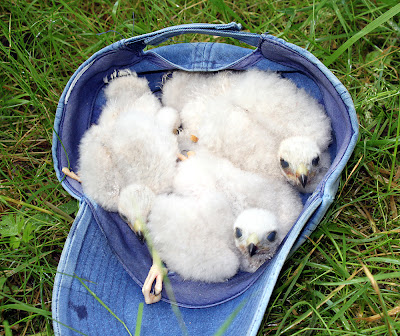With a flock of Goldfinch knocking about, overflying Siskins and Redpolls, and then an overhead Crossbill, this morning’s birding had a definite autumnal feel. Read on.
After a two week gap caused by the persistent poor weather Will and I agreed to be on the moss for a 6am ringing session not knowing quite what to expect. By all the accounts on bird blogs, forums and websites the breeding season has been disastrous for open, near ground nesting insectivorous birds like Sedge Warbler, Whitethroat and Willow Warbler, perhaps less so for birds with nests in thick cover or tree situations, like Goldfinch, Linnet and Greenfinch; in the last week I have caught 16 Goldfinch in the garden, almost 50% of them juveniles.
Today we caught 15 new birds, 3 Whitethroat, 2 Blackcap, 2 Willow Warbler, 2 Chiffchaff, 1 Garden Warbler, 1 Wren, 2 Blue Tit, 1 Chaffinch and 1 Great Tit. The catch was rather limited to be able to deduce much from the adult/juvenile ratio except that the three Whitethroats were all juveniles, but three only is not much of a catch on this site; sadly they were the first juvenile “whites” caught this year. On a more postive note we watched a pair of Whitethroats still feeding young close to our ringing station, and if the better weather holds, the young should fledge. Today’s Blackcap, Willow Warbler and Chiffchaff numbers split 50/50 adults and juveniles.
Although instructive to study, late July is not the ideal time to see birds in the hand, a time of year when most adults are in heavy moult, and even recently fledged youngsters start a partial moult of feathers. Today’s adult Garden Warbler had heavy wear to many feathers, especially noticeable in the primary coverts and tertials.
Garden Warbler
The juvenile Chiffchaff is moulting head feathers. If in doubt, the emarginated 6th primary feather and shorter, more rounded wing shape distinguishes a Chiffchaff from a Willow Warbler.
Chiffchaff
Chiffchaff
Juvenile Whitethroats tend to look good a little longer than other juvenile warblers.
Whitethroat
An adult female Blackcap showing considerable wear just about all over.
Blackcap
The morning’s birding highlights proved to be:
Siskins overhead from 6am, a noticeable southerly movement involving singles and small groups totalling 20+ birds, plus a minimum of 4 Lesser Redpoll heading south soon after 6 am. A single Crossbill called loudly as it flew north about 0900.
Later we noted a flock of 75+ Goldfinch on thistles, an indication that for these birds at least, the breeding season is over. Small numbers of Linnets today with probably just local birds numbering 20+, and a token appearance for a couple of Greenfinches.
Hirundines and Swifts: 100+ Swallow, 30+ House Martin, 6 Swift. My own thought is that many Swifts left last week, with a number of large concentrations seen, e.g. 300+ high over Cockerham Marsh on 20th July.
Raptors today: 2 Kestrel, 1 Sparrowhawk, 5 Buzzard.
Buzzard
The weathermen predict 30 degrees next week. If so there should be plenty of Buzzards in the air and lots of bunnies to go around, fat and healthy after eating all the lush greenery we have at the moment.



















































.jpg)












